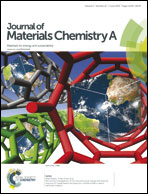Ordered mesoporous titania from highly amphiphilic block copolymers: tuned solution conditions enable highly ordered morphologies and ultra-large mesopores†
Abstract
Crystalline transition metal oxides with controlled mesopore architectures are in increasing demand to enhance the performance of energy conversion and storage devices. Solution based block copolymer self-assembly routes to achieve ordered mesoporous and crystalline titania have been studied for more than a decade, but have so far mostly been limited to water and alcohol dispersible polymers. This constraint has limited the accessible morphology space as well as structural dimensions. Moreover, synthetic approaches are mostly performed in a trial-and-error fashion using chemical intuition rather than being based on well-defined design parameters. We present solubility design guidelines that facilitate coassembly with highly amphiphilic block copolymers, enabling the formation of ordered structures with diverse length scales (d10 = 13.8–63.0 nm) and bulk-type morphologies. Thus, highly ordered and crystalline titania with the largest reported pores (d = 32.3 nm) was demonstrated for such a coassembly approach without the use of pore-expanders. Furthermore, the use of an ABC triblock terpolymer system led to a 3D ordered network morphology. In all cases, subsequent calcination treatments, such as the CASH procedure, enabled the formation of highly crystalline mesoporous materials while preserving the mesostructure.



 Please wait while we load your content...
Please wait while we load your content...